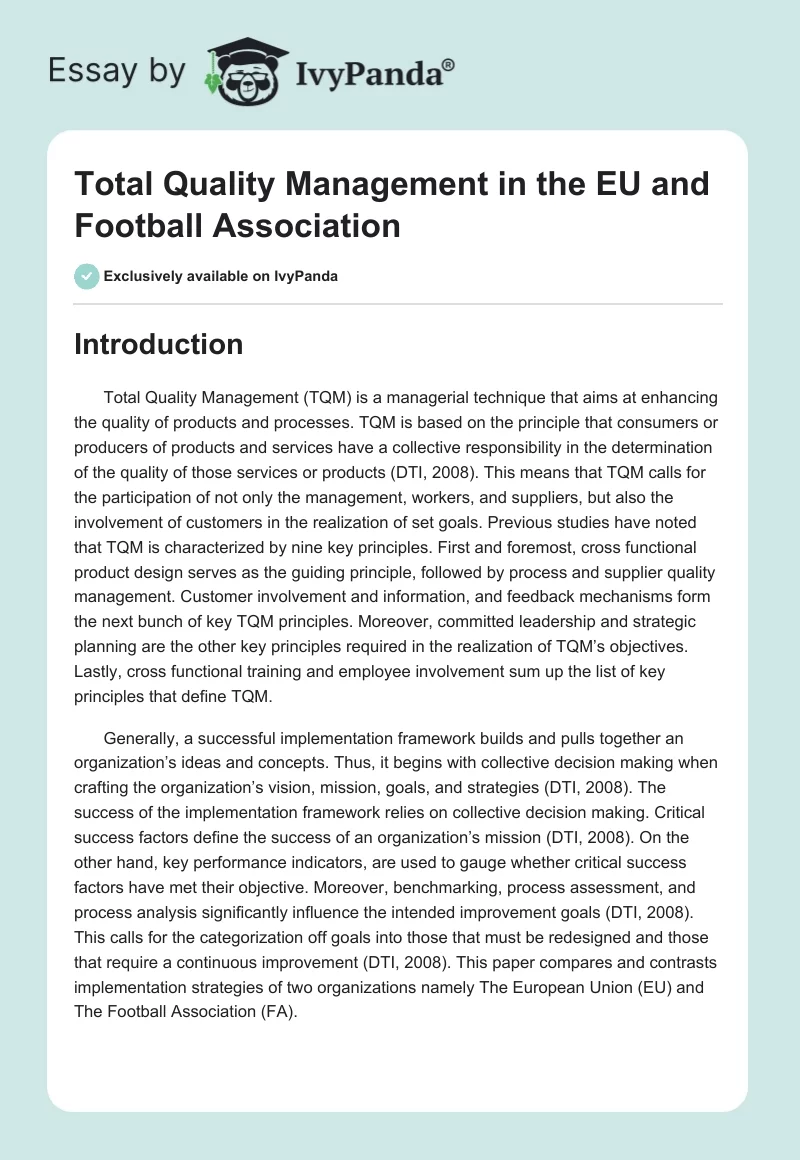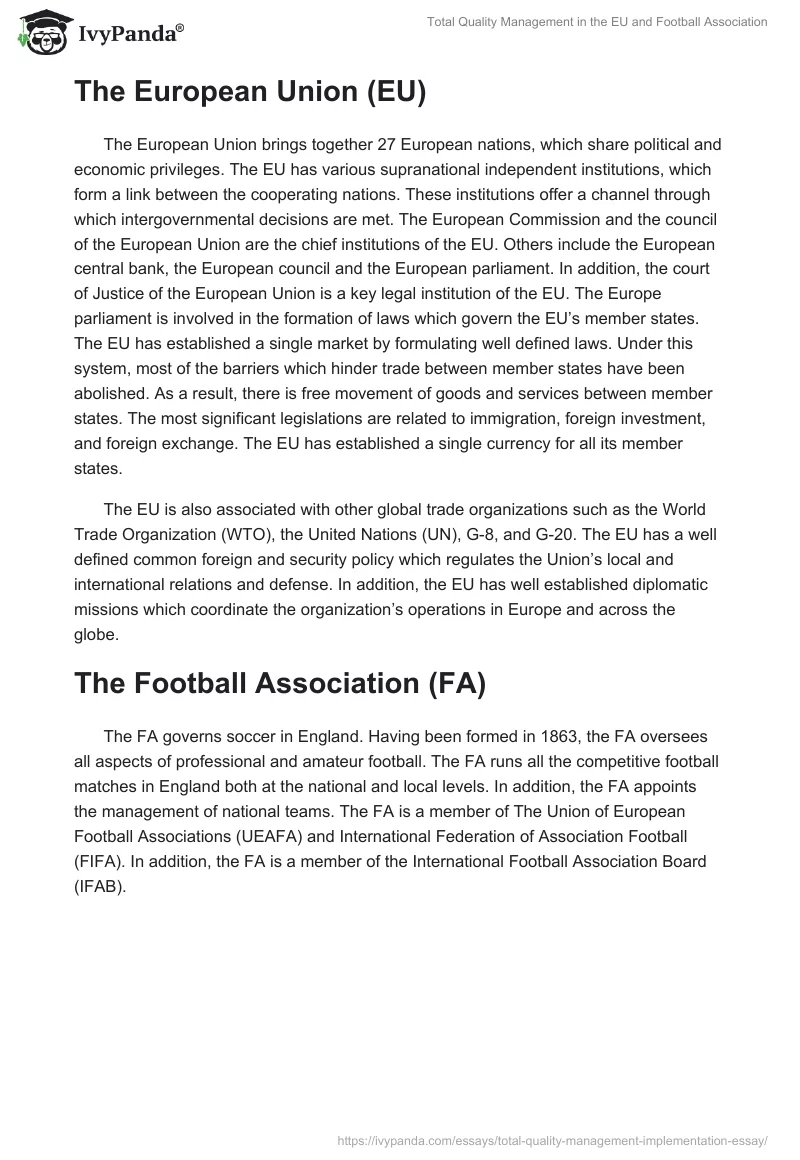Introduction
Total Quality Management (TQM) is a managerial technique that aims at enhancing the quality of products and processes. TQM is based on the principle that consumers or producers of products and services have a collective responsibility in the determination of the quality of those services or products (DTI, 2008). This means that TQM calls for the participation of not only the management, workers, and suppliers, but also the involvement of customers in the realization of set goals.
Previous studies have noted that TQM is characterized by nine key principles. First and foremost, cross-functional product design serves as the guiding principle, followed by process and supplier quality management. Customer involvement information and feedback mechanisms form the next bunch of key TQM principles. Moreover, committed leadership and strategic planning are the other key principles required in the realization of TQM’s objectives. Lastly, cross-functional training and employee involvement sum up the list of key principles that define TQM.
Generally, a successful implementation framework builds and pulls together an organization’s ideas and concepts. Thus, it begins with collective decision-making when crafting the organization’s vision, mission, goals, and strategies (DTI, 2008). The success of the implementation framework relies on collective decision-making. Critical success factors define the success of an organization’s mission (DTI, 2008).
On the other hand, key performance indicators, are used to gauge whether critical success factors have met their objective. Moreover, benchmarking, process assessment, and process analysis significantly influence the intended improvement goals (DTI, 2008). This calls for the categorization off goals into those that must be redesigned and those that require continuous improvement (DTI, 2008). This paper compares and contrasts implementation strategies of two organizations namely The European Union (EU) and The Football Association (FA).
The European Union (EU)
The European Union brings together 27 European nations, which share political and economic privileges. The EU has various supranational independent institutions, which form a link between the cooperating nations. These institutions offer a channel through which intergovernmental decisions are met. The European Commission and the Council of the European Union are the chief institutions of the EU. Others include the European Central Bank, the European Council and the European Parliament. In addition, the Court of Justice of the European Union is a key legal institution of the EU.
The European Parliament is involved in the formation of laws which govern the EU’s member states. The EU has established a single market by formulating well-defined laws. Under this system, most of the barriers which hinder trade between member states have been abolished. As a result, there is free movement of goods and services between member states. The most significant legislations are related to immigration, foreign investment, and foreign exchange. The EU has established a single currency for all its member states.
The EU is also associated with other global trade organizations such as the World Trade Organization (WTO), the United Nations (UN), G-8, and G-20. The EU has a well-defined common foreign and security policy which regulates the Union’s local and international relations and defence. In addition, the EU has well-established diplomatic missions which coordinate the organization’s operations in Europe and across the globe.
The Football Association (FA)
The FA governs soccer in England. Having been formed in 1863, the FA oversees all aspects of professional and amateur football. The FA runs all the competitive football matches in England both at the national and local levels. In addition, the FA appoints the management of national teams. The FA is a member of The Union of European Football Associations (UEAFA) and the International Federation of Association Football (FIFA). In addition, the FA is a member of the International Football Association Board (IFAB).
Implementation Strategies: The EU versus the FA
Similarities
Both organizations have used two key implementation strategies: setting the direction of the organization and managing processes. As mentioned earlier, a successful implementation framework builds and pulls together an organization’s ideas and concepts. Thus, begins with collective decision-making when crafting the organization’s vision, mission, goals, and strategies. With regard to the EU, it can be noted that various institutions have been formulated, which allow for the coordination of processes between the member states. These institutions are managed independently, and this ensures fair play.
Each institution has been given specific roles. These institutions collect different views from all member states of the EU before agreeing on the final decision. These institutions have established mechanisms, which protect member states from harassment and exploitation. The most significant institution in the EU is the European Parliament. The European Parliament is involved in the formation and amendment of laws which govern the EU’s member states.
On the other hand, the FA is a single body with well-defined rules and regulations. The FA Board is involved in the formulation and amendment of laws, which govern all the organization’s activities and practices. The presence of the board necessitates collective decision-making. Since the FA is a local body, it is involved in the management of soccer in England only. It has established local and national administrative regions, through which dispute resolution is channelled. Besides, it sends representatives to man soccer matches. This enables the FA to monitor all activities and collect first-hand information.
Differences
The EU’s operations rely mainly on various supranational independent institutions, which form a link between the cooperating nations. These institutions offer a channel through which intergovernmental decisions are met. This form of arrangement diverts decision-making to various customized institutions. This approach has a number of advantages. First, decisions are made without delay. Unlike in the FA where a single board is involved in decision-making, the EU has various institutions, which deal with specific issues.
In addition, decentralized decision-making enables the organization harness the most appropriate results from a given sector owing to customized decision-making. Customized decision-making enables experts from different member states to formulate tailor-made solutions. Another difference is based on self-analysis. The EU has established mechanisms that necessitate self-analysis. Again, the European Parliament and the Court of Justice of the European Union are the main institutions used to achieve self-analysis. On the contrary, the FA neither has a court nor a parliament of its own. Thus, dispute resolutions are conducted by a third party.
Differences in Terms of Soft and Hard Aspects of TQM Implementation
Rahman and Bullock (2002) argue that the top management acts at the driving force for TQM. According to Rahman and Bullock (2002), hard aspects of TQM have a direct influence on the performance of an organization. Hard aspects of TQM involve designing of products and services and taking precautions to avoid the generation of poor products and services. On the hand, soft aspects of TQM necessitate the effective adoption and utilization of hard aspects. In turn, soft aspects of TQM shape the organization’s performance indirectly though their impact on hard TQM elements.
In this case, the EU has employed several hard TQM elements. First of all, the EU has established parliamentary and judicial systems. The European parliament is involved in the formation of rules and regulations which guide the operations and activities of the union. This in part, affects the top management of the EU. In addition, Rahman and Bullock (2002) argue that an organization’s overall performance is determined by the quality of information used. Such quality is dependent on the use of sound customer feedback systems, and proper communication protocols within and beyond the organization.
The EU has met these requirements by setting up diplomatic offices across Europe and around the world. In addition, the EU has a well-defined common foreign and security policy which regulates the Union’s local and international relations and defence. On the contrary, the use of hard elements of TQM by the FA is evident in its ultra-modern communication system. The FA has advanced communication technologies, which are involved in the monitoring of the association’s activities.
As mentioned earlier, soft elements of TQM shape the organization’s performance indirectly, through their effect on hard aspects of TQM. Soft TQM aspects such as shared vision, workforce commitment, and customer focus are essential in the determination of an organization’s overall performance. Looking at the FA, it can be noted that the association has a well-defined customer feedback mechanism. This has been achieved by placing representatives at the national and local levels, and at every sporting occasion. On top of that, the FA’s vision has been incorporated in the guidelines that monitor all soccer activities at both at the national and local levels. On the contrary, the EU’s soft aspects of TQM are implemented by different institutions.
Conclusion
This paper has noted that TQM is based on the principle that consumers or producers of products and services have a collective responsibility in the determination of the quality of those services or products. This means that TQM calls for the participation of not only the management, workers, and suppliers, but also the involvement of customers in the realization of set goals. A successful implementation framework builds and pulls together an organization’s ideas and concepts. This must begin with collective decision-making when crafting the organization’s vision, mission, goals, and strategies. Both the EU and FA have used two key implementation strategies: setting the direction of the organization and managing processes.
With regard to the EU, it can be noted that various institutions have been formulated, which allow for the coordination of processes between the member states. On the other hand, the FA is a single body with well-defined rules and regulations. In addition, the EU has established parliamentary and judicial systems, which are formidable hard TQM elements. Moreover, the use of hard elements of TQM by the FA is evident in its ultra-modern communication system. Looking at the FA, it can be noted that the association has a well-defined customer feedback mechanism. This has been achieved by placing representatives at the national and local levels, and at every sporting occasion. On the contrary, the EU’s soft aspects of TQM are implemented by different institutions.
References
Department of Trade and Industry (DTI). (2008). Implement – from Quality to Organisational Excellence. Web.
Rahman, S. and Bullock, P. (2002). Relationships Between Soft TQM, Hard TQM, and Organisational Performance. Web.


